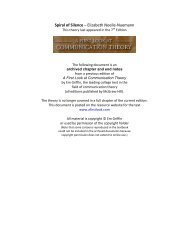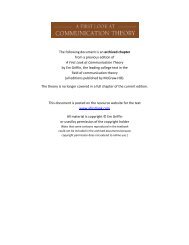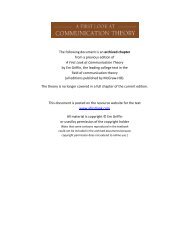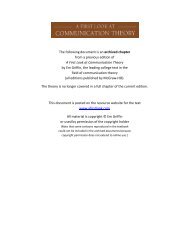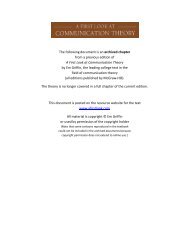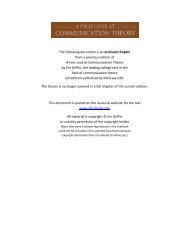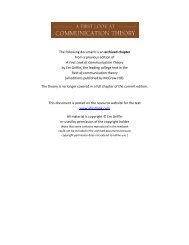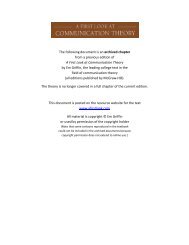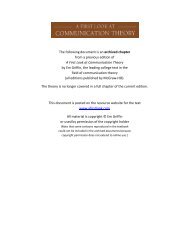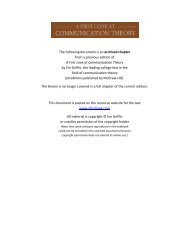Adaptive Structuration Theory of Marshall Scott Poole
Adaptive Structuration Theory of Marshall Scott Poole
Adaptive Structuration Theory of Marshall Scott Poole
Create successful ePaper yourself
Turn your PDF publications into a flip-book with our unique Google optimized e-Paper software.
CHAPTER 18: ADAPTIVE STRUCTURATION THEORY<br />
241<br />
don't want to ride roughshod over one or two people and then see them be bitter<br />
for the rest <strong>of</strong> the term. But Pete and Megan want a formal vote so that<br />
everyone is on record as supporting the decision. The group ends up appropriating<br />
both structures! When Josh, Paige, and Andrew coalesce around a compromise<br />
plan <strong>of</strong> reading the entire book yet concentrating class time on just 12<br />
theories, no vote is taken until all doubts and hesitations are worked through.<br />
With some fine-tuning, the class crafts a plan that all 12 <strong>of</strong> you can embrace, and<br />
then Josh calls for a unanimous vote-a ritual to seal your mutual commitment.<br />
RESEARCHING THE USE OF RULES AND RESOURCES<br />
Group decision support<br />
systems (GDSS)<br />
Media technology designed<br />
to promote democratic<br />
decision making<br />
by displaying all ideas<br />
anonymously.<br />
Faithful appropriation<br />
Using a rule or resource<br />
as it was originally<br />
intended.<br />
Ironic appropriation<br />
Using a rul e or resource<br />
ina way that thwarts its<br />
original purpose.<br />
Working with DeSanctis, <strong>Poole</strong> has spent the bulk <strong>of</strong> his structuration research<br />
exploring how groups use computerized group decision support systems (GDSS)high-tech<br />
media that have the potential to improve meetings and help make<br />
better decisions. Since new media scholars find adaptive structuration theory<br />
helpful in understanding the interface between computers and users, perhaps<br />
this is the theory that Andrew is looking for. I won't attempt to explain the<br />
hardware and s<strong>of</strong>tware <strong>of</strong> computer-assisted meetings, but structures built into<br />
the system are designed to promote democratic decision making. These structures<br />
include features such as equal opportunity to participate, one vote per<br />
person, and anonymous idea generation and balloting so that every member<br />
feels safe to participate.<br />
Just as we refer to the "spirit <strong>of</strong> the law," <strong>Poole</strong> and DeSanctis call the values<br />
behind the system the "spirit <strong>of</strong> the technology." They explain that "spirit is the<br />
principle <strong>of</strong> coherence that holds a set <strong>of</strong> rules and resources together.,,21 In<br />
<strong>Poole</strong>'s terms, a faithful appropriation <strong>of</strong> the technology is one that is consistent<br />
with the spirit <strong>of</strong> the resource. For example, suppose your experimental communication<br />
theory class met in a GDSS-equipped lab on campus to make final<br />
decisions about the course. A faithful appropriation <strong>of</strong> these rules and resources<br />
would be to use the system in a way that gives Lauren a real voice in the discussion<br />
while making it hard for Josh to dominate it.<br />
Although your classroom isn't GDSS-equipped, it has a built-in computer<br />
with video projection capacity, so most <strong>of</strong> you use PowerPoint technology when<br />
you present the results <strong>of</strong> your research. Pete's report on constructivism turns<br />
out to be a real media event (see Chapter 8). Backgrounds change, words tumble<br />
into place, text dissolves, clip art scrolls. The sight and sound <strong>of</strong> exploding fireworks<br />
punctuate Pete's announcement that he found a journal article by Delia<br />
that the textbook doesn't mention. And when he suggests that his high RCQ<br />
score certifies him as cognitively complex, a picture <strong>of</strong> the Mona Lisa smiles. The<br />
class laughs throughout and applauds wildly when it's over.<br />
<strong>Poole</strong> notes that group members sometimes appropriate rules or resources<br />
in ways that thwart their intended use. He calls this an ironic appropriation<br />
because it goes against the spirit <strong>of</strong> the structure. This seems to be the case with<br />
Pete's use <strong>of</strong> PowerPoint. By projecting over a hundred slides in a lO-minute<br />
presentation, he uses it to dazzle rather than clarify. His most vivid slides<br />
underscore his reactions to the theory rather than creating a deeper understanding<br />
<strong>of</strong> cognitive complexity, goal-based message plans, or person-centered<br />
messages. In the discussion that follows, Pete admits with a wry smile, "The<br />
devel<strong>of</strong>ers <strong>of</strong> PowerPoint would probably be shocked at how I used the system.,,2<br />
<strong>Poole</strong> doesn't think all adaptations <strong>of</strong> technology or other rules and



